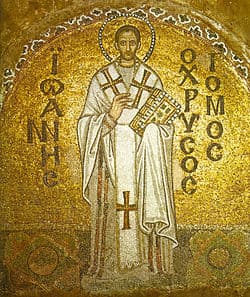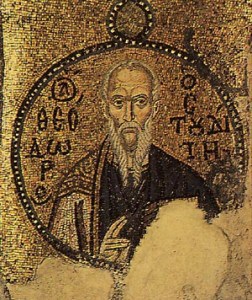Parish Bulletin – November 11, 2012
23RD SUNDAY AFTER PENTECOST
TONE 6
VENERABLE THEODORE OF STUDION; MARTYRS MENAS, VICTOR AND VINCENT
Ephesians 2:4-10
Luke 10:25-37
Choir Director: Veronika
Welcome
We welcome you to the Orthodox Church. Please feel at ease and free to participate in the singing. As a visitor you are welcome to come forward at the conclusion of the Divine Liturgy and venerate the Cross offered by the priest. Additionally you may receive the blessed bread (Antidoron) that is offered at that time. If you have questions or would like further information, the priest or one of the members of the parish will be pleased to help.
A word to our visitors on Holy Communion
The Orthodox Church does not practice open Communion. Therefore, only members of Canonical Orthodox Churches exercising jurisdiction in America may approach the Chalice for Holy Communion. The Orthodox do not regard Holy Communion solely as an act of personal piety, but also as an expression of union with the Orthodox Church’s faith, doctrine, and discipline. Orthodox visitors wishing to receive Holy Communion should make their intention known to the priest in advance — ask any member of the parish for help in relaying your intention to the priest. Orthodox Christians should prepare themselves to receive the Sacrament of Holy Communion through recent Confession, prayers of preparation for Holy Communion, and fasting (at minimum, from midnight before receiving).
“Whoever, therefore, eats the bread or drinks the cup of the Lord in a an unworthy manner will be guilty of profaning the body and blood of the Lord.” – I Corinthians 11:27
TROPARIA AND KONTAKIA
Troparion to the Martyrs – Tone 4
Thy martyrs, O Lord our God, * have received imperishable crowns from Thee in their sufferings; * for, possessed of Thy might, they set at nought the tyrants, * and destroyed the audacity of demonic weakness. * By their prayers do Thou save our souls.
Troparion to St. Theodore – Tone 8
Champion of Orthodoxy, teacher of purity and of true worship, * enlightener of the universe and adornment of hierarchs: * all-wise Father Theodore, your teachings have gleamed with light upon all things. * Intercede before Christ God to save our souls!
Kontakion to the Martyrs – Tone 4
O Passion-bearer Minas, * Christ our God, the imperishable Crown of martyrs, * took thee from a transient army, * and showed thee forth * as a partaker of the incorruptible and heavenly.
Kontakion to St. Theodore – Tone 2
Thine ascetic life, equal to an angel’s, * made thee radiant through thine athlete’s contest; * blessed by God, O Theodore, * thou didst become a companion of the angels, * with whom thou unceasingly dost intercede for us all.
Opportunities to give:
➢ Food donations to the Ashland Food Project
Announcements:
- Please sign up for coffee fellowship/kitchen cleanup.
- Choir practice on Saturday, 3.00 pm.
- Annual Parish Meeting will take place today, with a pre-fasting “Thanksgiving meal.”
- Be ready to hand in your Pledge Forms at the end of the Parish Meeting.
- Parish Council Meeting after Liturgy next Sunday.
- The Nativity Fast begins this Wednesday. For your own spiritual benefit, please observe it to the best of your ability!
Service Schedule this Week:
Wednesday – 6.00 pm, Vespers
Thursday – 6.40 am, Hours, Divine Liturgy
Saturday – 6.00 pm, Great Vespers
Sunday – 8.40 am, Hours, Divine Liturgy
Confession after Vespers or by appointment!
Other Activities Next Week:
- Saturday, 3.00 PM – Choir practice (at the Bloms’ house)
Bulletin Insert (OCA Department of Education):
On November 13th and 14th, the Church celebrates two saints who lived and worked in the city of Constantinople. The first is John Chrysostom, and the second is the Emperor Justinian.
 Saint John Chrysostom did so many important things that he is one of the best-known people who ever lived in the great city. One action that stands out is his speaking against moral laxness. He insisted that priests and bishops, especially, hold themselves to a high standard of moral behavior, and urged them to serve as examples both to believers and to those outside the Church.
Saint John Chrysostom did so many important things that he is one of the best-known people who ever lived in the great city. One action that stands out is his speaking against moral laxness. He insisted that priests and bishops, especially, hold themselves to a high standard of moral behavior, and urged them to serve as examples both to believers and to those outside the Church.
We might assume that his stance would be welcomed and supported by all the clergy. But there were those among them who had become accustomed to a life that didn’t demand much of them in terms of moral living or hard work, and they deeply resented Chrysostom. He endured real hatred from those who had no desire to live up to the standards he set, and they watched with jealousy as he became a famous preacher and, more importantly, a spiritual shepherd loved and trusted by the people. He suffered from their envy, and it finally led to his exile and death. But he never abandoned his struggle to live as a true follower of Christ.
Justinian was born in 482, about 75 years after Chrysostom’s death. His unusually long reign, from 527 to 565, was as full of notable events as Chrysostom’s life had been. He planned aggressive military campaigns to regain territory that had been lost, especially in North Africa and Italy. His effort was so successful that by the time he died in 565, the Empire extended further than it ever would under the rulers who followed him.
Justinian wrote hymns, created a code of laws (the “Justinian Codex”) to bring order to the life of the Empire, and lived as a serious Christian. He kept the fasts and observed the feasts, urging others to do the same, whether they were members of his court or simple citizens.
The rebuilding of the cathedral of Hagia Sophia was one of the great achievements of Justinian’s reign. He undertook a massive program of construction throughout Constantinople, which was described in a treatise written by the court historian. The cathedral, being the central place of Christian worship in the Empire, was the most notable part of his effort.Hagia Sophia is known for its design and grand scale, as well as its soaring dome. At least two of the architects Justinian selected had been trained in physics and mathematics, and they were able to create a structure that has impressed thousands of visitors since their work was completed in 537.
Though it is no longer a place of worship for Christians, Hagia Sophia is still a reminder of the shining days of Constantinople. The two saints commemorated in mid-November, John and Justinian, did much to make the city a place where God was honored and truly worshiped.


Leave a Reply